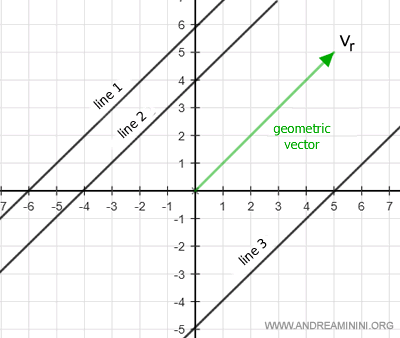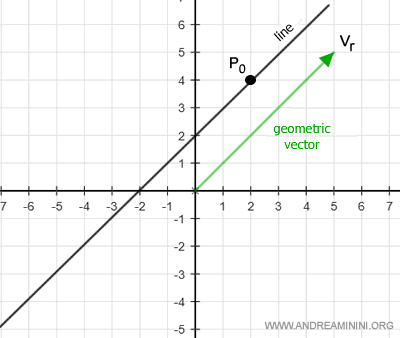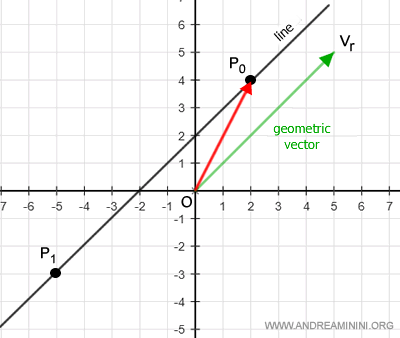How to Represent a Line Using a Vector
A geometric vector defines a direction that is shared by all lines in the plane parallel to it.

Therefore, any line in the plane can be described by:
- a non-trivial geometric vector vr, known as the direction vector, indicating the direction of the line: $$ v_r = \begin{pmatrix} l \\ m \end{pmatrix} $$
The parameters l and m are the direction parameters of the line.
- a specific point P0 on the plane through which the line passes: $$ P_0 = \begin{pmatrix} x_0 \\ y_0 \end{pmatrix} $$
Example

A point on the plane belongs to the line if there exists a scalar α such that
$$ OP = OP_0 + α v_r $$
Example
Consider the point P1 with coordinates (-5, -3).

The point P1 belongs to the line if
$$ OP_1 = OP_0 + α v_r $$
$$ \begin{pmatrix} -5 \\ -3 \end{pmatrix} = \begin{pmatrix} 2 \\ 4 \end{pmatrix} + α \begin{pmatrix} 5 \\ 5 \end{pmatrix} $$
Solving the system of equations to find the scalar α:
$$ \begin{cases} -5 = 2 + α5 \\ -3 = 4 + α5 \end{cases} = \begin{cases} α = - \frac{7}{5} \\ α = - \frac{7}{5} \end{cases} $$
The system solves with the scalar α = -7/5.
In fact:
$$ \begin{pmatrix} -5 \\ -3 \end{pmatrix} = \begin{pmatrix} 2 \\ 4 \end{pmatrix} + α \begin{pmatrix} 5 \\ 5 \end{pmatrix} $$
$$ \begin{pmatrix} -5 \\ -3 \end{pmatrix} = \begin{pmatrix} 2 \\ 4 \end{pmatrix} + \begin{pmatrix} 5α \\ 5α \end{pmatrix} $$
$$ \begin{pmatrix} -5 \\ -3 \end{pmatrix} = \begin{pmatrix} 2 \\ 4 \end{pmatrix} + \begin{pmatrix} 5 \cdot ( - \frac{7}{5} ) \\ 5 \cdot ( - \frac{7}{5} ) \end{pmatrix} $$
$$ \begin{pmatrix} -5 \\ -3 \end{pmatrix} = \begin{pmatrix} 2 \\ 4 \end{pmatrix} + \begin{pmatrix} -7 \\ -7 \end{pmatrix} $$
$$ \begin{pmatrix} -5 \\ -3 \end{pmatrix} = \begin{pmatrix} 2 - 7 \\ 4 - 7 \end{pmatrix} $$
$$ \begin{pmatrix} -5 \\ -3 \end{pmatrix} = \begin{pmatrix} -5 \\ -3 \end{pmatrix} $$
We can generalize this result by stating that
All coordinates of all points on the line are characterized by the following equation, called the vector equation of the line: $$ \begin{pmatrix} x \\ y \end{pmatrix} = \begin{pmatrix} x_0 \\ y_0 \end{pmatrix} + α \cdot \begin{pmatrix} l \\ m \end{pmatrix} $$Converting the vector equation into a system of equations, we get the parametric equations of the line:$$ \begin{cases} x = x_0 + α l \\ y = y_0 + α m \end{cases} $$
There are infinitely many vector and parametric equations because there are infinitely many multiples of the direction vector.
Cartesian Equations
The vector P0P1 is parallel to the direction vector vr.
According to theory, a vector is parallel and proportional to another if
$$ \begin{pmatrix} x-x_0 & l \\ y - y_0 & m \end{pmatrix} \le 1 $$
This is true if
$$ det \begin{pmatrix} x-x_0 & l \\ y - y_0 & m \end{pmatrix} = 0 $$
Calculating the determinant, we get
$$ m ( x-x_0 ) - l ( y - y_0 ) = 0 $$
This gives us the Cartesian equation.
Similarly, there are infinitely many Cartesian equations.
